In Vitro and In Silico Analysis of PTP1B Inhibitors from Cleistocalyx operculatus Leaves and Their Effect on Glucose Uptake
Abstract
1. Introduction
2. Materials and Methods
2.1. General Experimental Procedures
2.2. Plant Material
2.3. Extraction and Isolation
2.4. Spectroscopic and Physical Characteristic of Compounds
2.5. In Vitro PTP1B Inhibition Assay
2.6. Kinetic Analysis with PTP1B
2.7. Cell Culture and Differentiation of 3T3-L1 Adipocytes
2.8. Measurement of Glucose Uptake Using the 2-NBDG Probe
2.9. Molecular Docking Studies on the PTP1B Enzyme
2.10. Statistical Analysis
3. Results
3.1. Structure Elucidation of Compounds 1−3 from Cleistocalyx Operculatus
3.2. PTP1B Inhibitory Activity of Compounds 1−17 and Enzyme Kinetics
3.3. Structure Activity Relationship (SAR) Analysis and Molecular Docking Experiments
3.4. Effect of Stimulating Glucose Uptake in Adipocytes
4. Discussion
5. Conclusions
Supplementary Materials
Author Contributions
Funding
Institutional Review Board Statement
Informed Consent Statement
Data Availability Statement
Conflicts of Interest
References
- Sun, H.; Saeedi, P.; Karuranga, S.; Pinkepank, M.; Ogurtsova, K.; Duncan, B.; Stein, C.; Basit, A.; Chan, J.; Mbanya, J.; et al. IDF Diabetes Atlas: Global, regional and country-level diabetes prevalence estimates for 2021 and projections for 2045. Diabetes Res. Clin. Pract. 2022, 183, 109119. [Google Scholar] [CrossRef]
- Lin, X.; Xu, Y.; Pan, X.; Xu, J.; Ding, Y.; Sun, X.; Song, X.; Ren, Y.; Shan, P.-F. Global, regional, and national burden and trend of diabetes in 195 countries and territories: An analysis from 1990 to 2025. Sci. Rep. 2020, 10, 14790. [Google Scholar] [CrossRef]
- Saeedi, P.; Salpea, P.; Karuranga, S.; Petersohn, I.; Malanda, B.; Gregg, E.; Unwin, N.; Wild, S.; Williams, R. Mortality attributable to diabetes in 20–79 years old adults, 2019 estimates: Results from the International Diabetes Federation Diabetes Atlas, 9th edition. Diabetes Res. Clin. Pract. 2020, 162, 108086. [Google Scholar] [CrossRef]
- Bailey, C.J.; Krentz, A.J. Oral Glucose-Lowering Agents. In Text book of Diabetes, 5th ed.; Holt, R.I.G., Cockram, C.S., Flyvbjerg, A., Goldstein, B.J., Eds.; John Wiley & Sons, Ltd.: Hoboken, NJ, USA, 2017; pp. 426–454. [Google Scholar] [CrossRef]
- Tarry-Adkins, J.L.; Grant, I.D.; Ozanne, S.E.; Reynolds, R.M.; Aiken, C.E. Efficacy and side effect profile of different formulations of metformin: A systematic review and meta-analysis. Diabetes Ther. 2021, 12, 1901–1914. [Google Scholar] [CrossRef]
- Morino, K.; Petersen, K.F.; Shulman, G.I. Molecular mechanisms of insulin resistance in humans and their potential links with mitochondrial dysfunction. Diabetes 2006, 55, S9–S15. [Google Scholar] [CrossRef]
- Chen, H.; Cong, L.N.; Li, Y.; Yao, Z.J.; Wu, L.; Zhang, Z.Y.; Burke, T.R., Jr.; Quon, M.J. A phosphotyrosyl mimetic peptide reverses impairment of insulin-stimulated translocation of GLUT4 caused by overexpression of PTP1B in rat adipose cells. Biochemistry 1999, 38, 384–389. [Google Scholar] [CrossRef]
- Ramachandran, C.; Kennedy, B.P. Protein tyrosine phosphatase 1B: A novel target for type 2 diabetes and obesity. Curr. Top. Med. Chem. 2003, 3, 749–757. [Google Scholar] [CrossRef]
- Tao, J.; Malbon, C.C.; Wang, H.Y. Insulin stimulates tyrosine phosphorylation and inactivation of protein-tyrosine phosphatase 1B in vivo. J. Biol. Chem. 2001, 276, 29520–29525. [Google Scholar] [CrossRef]
- Gu, F.; Nguyen, D.T.; Stuible, M.; Dube, N.; Tremblay, M.L.; Chevet, E. Protein-tyrosine phosphatase 1B potentiates IRE1 signaling during endoplasmic reticulum stress. J. Biol. Chem. 2004, 279, 49689–49693. [Google Scholar] [CrossRef]
- Xie, L.; Lee, S.Y.; Andersen, J.N.; Waters, S.; Shen, K.; Guo, X.L.; Moller, N.P.; Olefsky, J.M.; Lawrence, D.S.; Zhang, Z.Y. Cellular effects of small molecule PTP1B inhibitors on insulin signaling. Biochemistry 2003, 42, 12792–12804. [Google Scholar] [CrossRef]
- Rines, A.K.; Sharabi, K.; Tavares, C.D.; Puigserver, P. Targeting hepatic glucose metabolism in the treatment of type 2 diabetes. Nat. Rev. Drug Discov. 2016, 15, 786–804. [Google Scholar] [CrossRef] [PubMed]
- Chinsembu, K.C. Diabetes mellitus and nature’s pharmacy of putative antidiabetic plants. J. Herb. Med. 2019, 15, 100230. [Google Scholar] [CrossRef]
- Akdad, M.; Eddouks, M. Glucose uptake: A promising target of medicinal plants. In Antidiabetic Medicinal Plants; Elsevier: Amsterdam, The Netherlands, 2024; pp. 409–440. [Google Scholar]
- Tran, N.; Pham, B.; Le, L. Bioactive compounds in anti-diabetic plants: From herbal medicine to modern drug discovery. Biology 2020, 9, 252. [Google Scholar] [CrossRef]
- Jiang, C.-S.; Liang, L.-F.; Guo, Y.-W. Natural products possessing protein tyrosine phosphatase 1B (PTP1B) inhibitory activity found in the last decades. Acta Pharmacol. Sin. 2012, 33, 1217–1245. [Google Scholar] [CrossRef]
- Dao, T.T.; Tung, B.T.; Nguyen, P.H.; Thuong, P.T.; Yoo, S.S.; Kim, E.H.; Kim, S.K.; Oh, W.K. C-methylated flavonoids from Cleistocalyx operculatus and their inhibitory effects on novel influenza A (H1N1) neuraminidase. J. Nat. Prod. 2010, 73, 1636–1642. [Google Scholar] [CrossRef]
- Mai, T.T.; Chuyen, N.V. Anti-hyperglycemic activity of an aqueous extract from flower buds of Cleistocalyx operculatus (Roxb.) Merr and Perry. Biosci. Biotechnol. Biochem. 2007, 71, 69–76. [Google Scholar] [CrossRef] [PubMed]
- Min, B.S.; Cuong, T.D.; Lee, J.S.; Shin, B.S.; Woo, M.H.; Hung, T.M. Cholinesterase inhibitors from Cleistocalyx operculatus buds. Arch. Pharm. Res. 2010, 33, 1665–1670. [Google Scholar] [CrossRef] [PubMed]
- Min, B.S.; Thu, C.V.; Dat, N.T.; Dang, N.H.; Jang, H.S.; Hung, T.M. Antioxidative flavonoids from Cleistocalyx operculatus buds. Chem. Pharm. Bull. 2008, 56, 1725–1728. [Google Scholar] [CrossRef] [PubMed]
- Truong, T.M.; Ishiwaki, A.; Nomi, Y.; Le, T.H.; Nguyen, T.L.; Nguyen, T.P.T.; Vuong, T.H.N.; Yamaguchi, K.; Otsuka, Y. Efficacy of an aqueous extract from flower buds of Cleistocalyx operculatus on type 2 diabetic patients in Vietnam. J. Home Econ. Jpn. 2013, 64, 3–9. [Google Scholar] [CrossRef]
- Mai, V.-H.; Ponce-Zea, J.E.; Doan, T.-P.; Vu, Q.H.; Ryu, B.; Lee, C.-H.; Oh, W.-K. Chalcone-Monoterpene Derivatives from the Buds of Cleistocalyx operculatus and Their Potential as Protein Tyrosine Phosphatase 1B Inhibitors. J. Nat. Prod. 2024. online ahead of print. [Google Scholar] [CrossRef] [PubMed]
- Pham, G.N.; Nguyen, T.T.T.; Nguyen-Ngoc, H. Ethnopharmacology, phytochemistry, and pharmacology of Syzygium nervosum. Evid.-Based Complement. Altern. Med. 2020, 2020, 8263670. [Google Scholar] [CrossRef] [PubMed]
- Wang, C.; Wu, P.; Tian, S.; Xue, J.H.; Xu, L.X.; Li, H.X.; Wei, X.Y. Bioactive pentacyclic triterpenoids from the leaves of Cleistocalyx operculatus. J. Nat. Prod. 2016, 79, 2912–2923. [Google Scholar] [CrossRef]
- Su, J.C.; Wang, S.; Cheng, W.; Huang, X.J.; Li, M.M.; Jiang, R.W.; Li, Y.L.; Wang, L.; Ye, W.C.; Wang, Y. Phloroglucinol derivatives with unusual skeletons from Cleistocalyx operculatus and their in vitro antiviral activity. J. Org. Chem. 2018, 83, 8522–8532. [Google Scholar] [CrossRef]
- Yang, J.L.; Ha, T.K.Q.; Lee, B.W.; Kim, J.; Oh, W.K. PTP1B inhibitors from the seeds of Iris sanguinea and their insulin mimetic activities via AMPK and ACC phosphorylation. Bioorg. Med. Chem. Lett. 2017, 27, 5076–5081. [Google Scholar] [CrossRef]
- Wiesmann, C.; Barr, K.J.; Kung, J.; Zhu, J.; Erlanson, D.A.; Shen, W.; Fahr, B.J.; Zhong, M.; Taylor, L.; Randal, M.; et al. Allosteric inhibition of protein tyrosine phosphatase 1B. Nat. Struct. Mol. Biol. 2004, 11, 730–737. [Google Scholar] [CrossRef] [PubMed]
- Diller, D.; Merz, K. High throughput docking for library design and library prioritization. Proteins 2001, 43, 113–124. [Google Scholar] [CrossRef] [PubMed]
- Kaneta, Y.; Arai, M.A.; Ishikawa, N.; Toume, K.; Koyano, T.; Kowithayakorn, T.; Chiba, T.; Iwama, A.; Ishibashi, M. Identification of BMI1 promoter inhibitors from Beaumontia murtonii and Eugenia operculata. J. Nat. Prod. 2017, 80, 1853–1859. [Google Scholar] [CrossRef]
- Ghosh, S. Triterpenoids: Structural diversity, biosynthetic pathway, and bioactivity. Stud. Nat. Prod. Chem. 2020, 67, 411–461. [Google Scholar]
- Nishimura, K.; Fukuda, T.; Miyase, T.; Noguchi, H.; Chen, X.M. Activity-guided isolation of triterpenoid acyl CoA cholesteryl acyl transferase (ACAT) inhibitors from Ilex kudincha. J. Nat. Prod. 1999, 62, 1061–1064. [Google Scholar] [CrossRef]
- Kang, K.B.; Kim, J.W.; Oh, W.K.; Kim, J.; Sung, S.H. Cytotoxic ceanothane- and lupane-type triterpenoids from the roots of Ziziphus jujuba. J. Nat. Prod. 2016, 79, 2364–2375. [Google Scholar] [CrossRef]
- Siewert, B.; Wiemann, J.; Kowitsch, A.; Csuk, R. The chemical and biological potential of C ring modified triterpenoids. Eur. J. Med. Chem. 2014, 72, 84–101. [Google Scholar] [CrossRef]
- Srivedavyasasri, R.; Hayes, T.; Ross, S.A. Phytochemical and biological evaluation of Salvia apiana. Nat. Prod. Res. 2017, 31, 2058–2061. [Google Scholar] [CrossRef] [PubMed]
- Taniguchi, S.; Imayoshi, Y.; Kobayashi, E.; Takamatsu, Y.; Ito, H.; Hatano, T.; Sakagami, H.; Tokuda, H.; Nishino, H.; Sugita, D.; et al. Production of bioactive triterpenes by Eriobotrya japonica calli. Phytochemistry 2002, 59, 315–323. [Google Scholar] [CrossRef] [PubMed]
- Jin, Q.; Jin, H.G.; Kim, A.R.; Woo, E.R. A new megastigmane palmitate and a new oleanane triterpenoid from Aster yomena Makino. Helv. Chim. Acta 2012, 95, 1455–1460. [Google Scholar] [CrossRef]
- Li, E.N.; Zhou, G.D.; Kong, L.Y. Chemical constituents from the leaves of Eriobotrya japonica. Chin. J. Nat. Med. 2009, 7, 190–192. [Google Scholar] [CrossRef]
- Liao, C.R.; Kuo, Y.H.; Ho, Y.L.; Wang, C.Y.; Yang, C.S.; Lin, C.W.; Chang, Y.S. Studies on cytotoxic constituents from the leaves of Elaeagnus oldhamii Maxim. in non-small cell lung cancer A549 cells. Molecules 2014, 19, 9515–9534. [Google Scholar] [CrossRef]
- Lee, K.H.; Lin, Y.M.; Wu, T.S.; Zhang, D.C.; Yamagishi, T.; Hayashi, T.; Hall, I.H.; Chang, J.J.; Wu, R.Y.; Yang, T.H. The cytotoxic principles of Prunella vulgaris, Psychotria serpens, and Hyptis capitata: Ursolic acid and related derivatives. Planta Med. 1988, 54, 308–311. [Google Scholar] [CrossRef]
- Tiganis, T. PTP1B and TCPTP--nonredundant phosphatases in insulin signaling and glucose homeostasis. FEBS J. 2013, 280, 445–458. [Google Scholar] [CrossRef] [PubMed]
- Zhang, S.; Zhang, Z.Y. PTP1B as a drug target: Recent developments in PTP1B inhibitor discovery. Drug Discov. Today 2007, 12, 373–381. [Google Scholar] [CrossRef]
- Ha, M.T.; Lee, T.H.; Kim, C.S.; Prajapati, R.; Kim, J.A.; Choi, S.; Min, B.S. PTP1B and α-glucosidase inhibitory activities of the chemical constituents from Hedera rhombea fruits: Kinetic analysis and molecular docking simulation. Phytochemistry 2022, 197, 113100. [Google Scholar] [CrossRef]
- Jiang, W.; Tang, Y.; Tong, Y.P.; Zhao, Z.Y.; Jin, Z.X.; Li, J.; Zang, Y.; Xiong, J.; Hu, J.F. Structurally diverse mono-/dimeric triterpenoids from the vulnerable conifer Pseudotsuga gaussenii and their PTP1B inhibitory effects. The role of protecting species diversity in support of chemical diversity. Bioorg. Chem. 2022, 124, 105825. [Google Scholar] [CrossRef]
- Gamede, M.; Mabuza, L.; Ngubane, P.; Khathi, A. The effects of plant-derived oleanolic acid on selected parameters of glucose homeostasis in a diet-induced pre-diabetic rat model. Molecules 2018, 23, 794. [Google Scholar] [CrossRef]
- Zhang, Y.N.; Zhang, W.; Hong, D.; Shi, L.; Shen, Q.; Li, J.Y.; Li, J.; Hu, L.H. Oleanolic acid and its derivatives: New inhibitor of protein tyrosine phosphatase 1B with cellular activities. Bioorganic Med. Chem. 2008, 16, 8697–8705. [Google Scholar] [CrossRef]
- Castellano, J.M.; Guinda, A.; Delgado, T.; Rada, M.; Cayuela, J.A. Biochemical basis of the antidiabetic activity of oleanolic acid and related pentacyclic triterpenes. Diabetes 2013, 62, 1791–1799. [Google Scholar] [CrossRef]
- Oboh, M.; Govender, L.; Siwela, M.; Mkhwanazi, B.N. Anti-diabetic potential of plant-based pentacyclic triterpene derivatives: Progress made to improve efficacy and bioavailability. Molecules 2021, 26, 7243. [Google Scholar] [CrossRef]
- Perez-Jimenez, A.; Rufino-Palomares, E.E.; Fernandez-Gallego, N.; Ortuno-Costela, M.C.; Reyes-Zurita, F.J.; Peragon, J.; Garcia-Salguero, L.; Mokhtari, K.; Medina, P.P.; Lupianez, J.A. Target molecules in 3T3-L1 adipocytes differentiation are regulated by maslinic acid, a natural triterpene from Olea europaea. Phytomedicine 2016, 23, 1301–1311. [Google Scholar] [CrossRef]
- Minh, T.T.L.; Kieu, L.T.B.; Mai, S.T.T.; Ngoc, D.L.B.; Thuy, L.B.; Quyen, N.T.; Anh, T.T.; Huy, L.; Phong, N.V.; Duyen, C.T.M.; et al. Addition of Mentha arvensis in infusions of Cleistocalyx operculatus improves the hedonic score and retains the high antioxidant and anti lipid-peroxidation effects. Appl. Sci. 2023, 13, 2873. [Google Scholar] [CrossRef]
- Suzuki, T.; Hiroki, A.; Watanabe, T.; Yamashita, T.; Takei, I.; Umezawa, K. Potentiation of insulin-related signal transduction by a novel protein-tyrosine phosphatase inhibitor, Et-3,4-dephostatin, on cultured 3T3-L1 adipocytes. J. Biol. Chem. 2001, 276, 27511–27518. [Google Scholar] [CrossRef]
- Xie, X.; Gong, Z.; Mansuy-Aubert, V.; Zhou, Q.L.; Tatulian, S.A.; Sehrt, D.; Gnad, F.; Brill, L.M.; Motamedchaboki, K.; Chen, Y.; et al. C2 domain-containing phosphoprotein CDP138 regulates GLUT4 insertion into the plasma membrane. Cell Metab. 2011, 14, 378–389. [Google Scholar] [CrossRef]
- Ishiki, M.; Klip, A. Minireview: Recent developments in the regulation of glucose transporter-4 traffic: New signals, locations, and partners. Endocrinology 2005, 146, 5071–5078. [Google Scholar] [CrossRef] [PubMed]
- Abel, E.D.; Peroni, O.; Kim, J.K.; Kim, Y.B.; Boss, O.; Hadro, E.; Minnemann, T.; Shulman, G.I.; Kahn, B.B. Adipose-selective targeting of the GLUT4 gene impairs insulin action in muscle and liver. Nature 2001, 409, 729–733. [Google Scholar] [CrossRef]
- Funaki, M.; Randhawa, P.; Janmey, P.A. Separation of insulin signaling into distinct GLUT4 translocation and activation steps. Mol. Cell. Biol. 2004, 24, 7567–7577. [Google Scholar] [CrossRef]
- Kampmann, U.; Christensen, B.; Nielsen, T.S.; Pedersen, S.B.; Orskov, L.; Lund, S.; Moller, N.; Jessen, N. GLUT4 and UBC9 protein expression is reduced in muscle from type 2 diabetic patients with severe insulin resistance. PLoS ONE 2011, 6, e27854. [Google Scholar] [CrossRef]
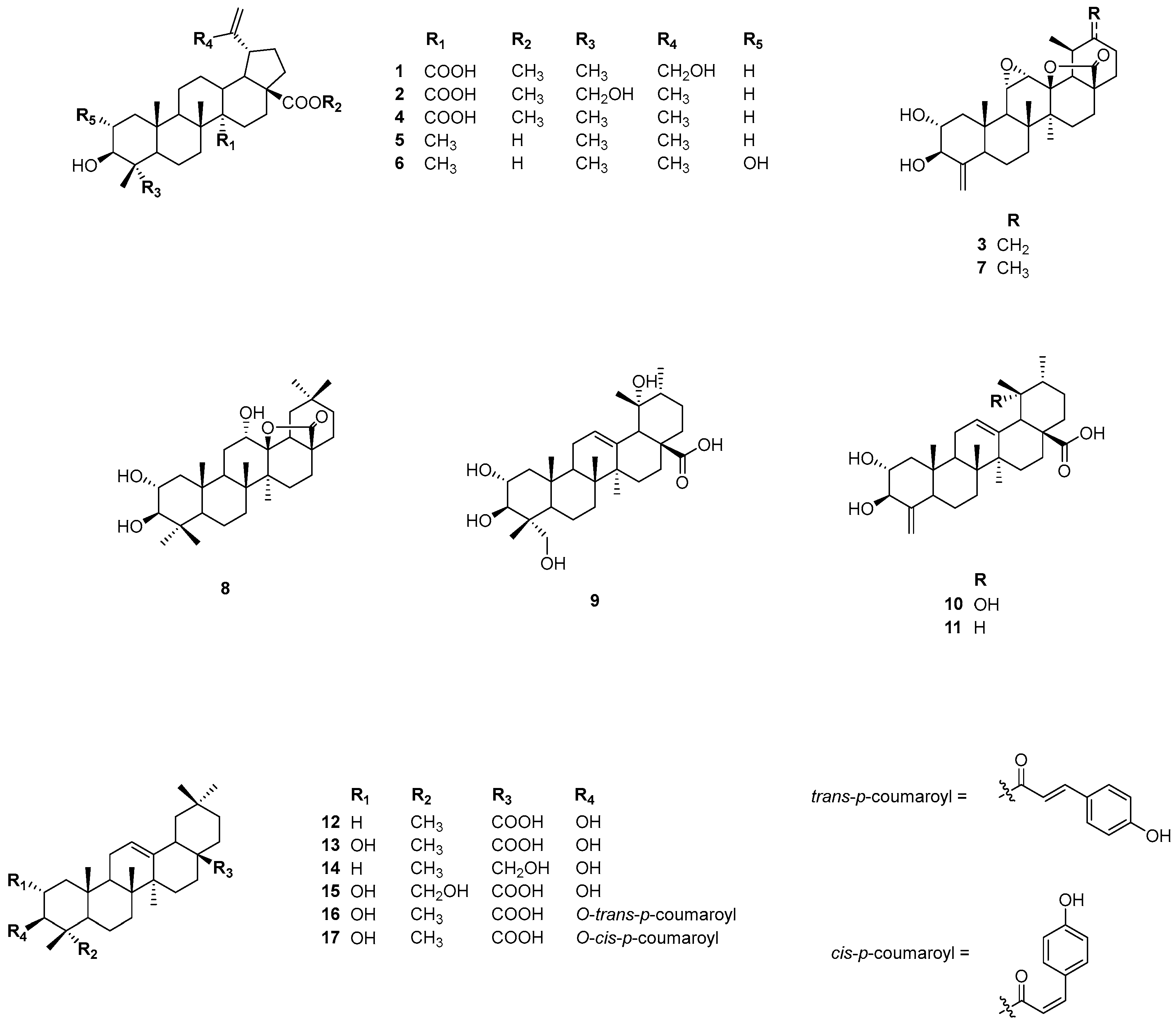
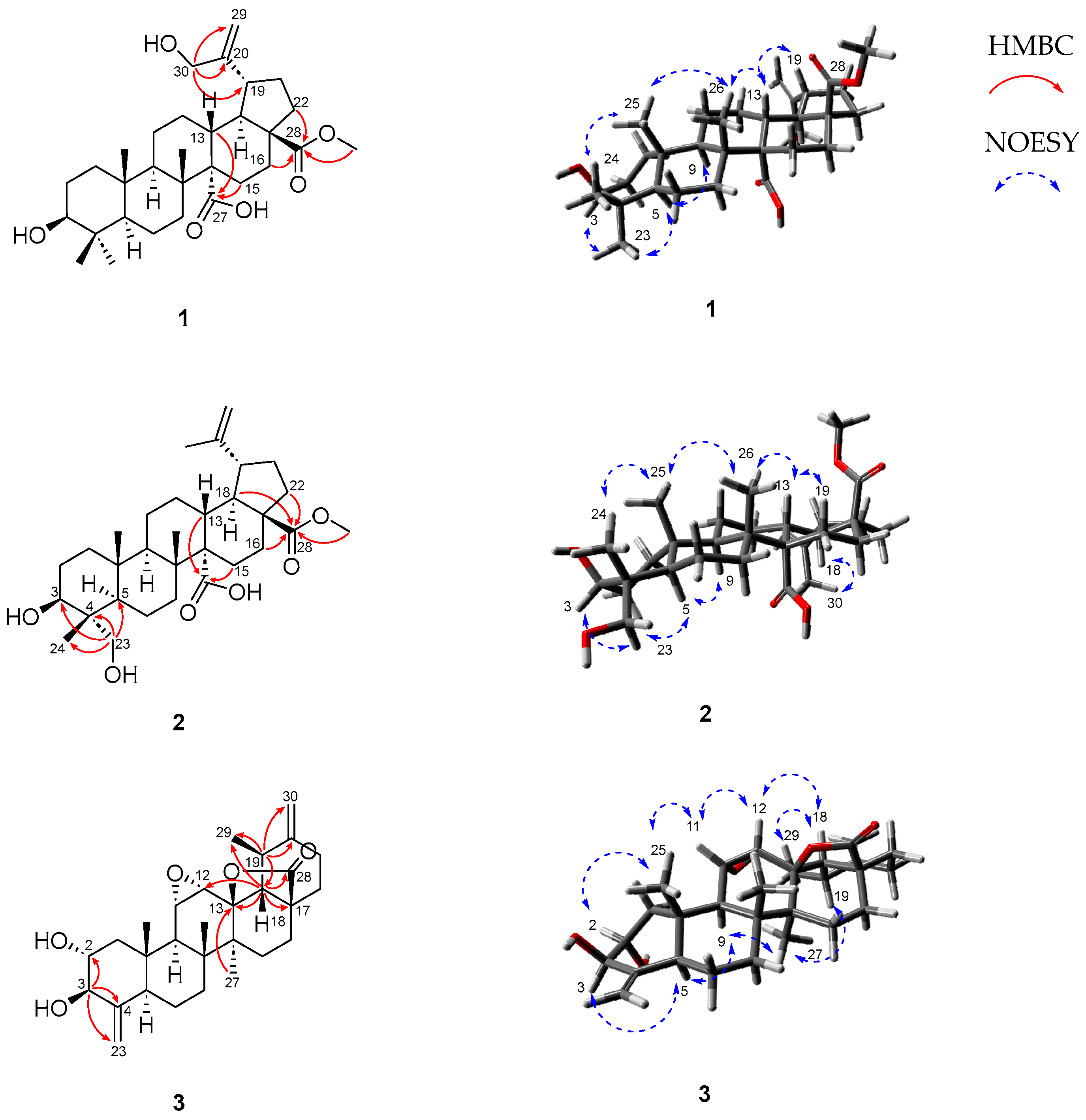
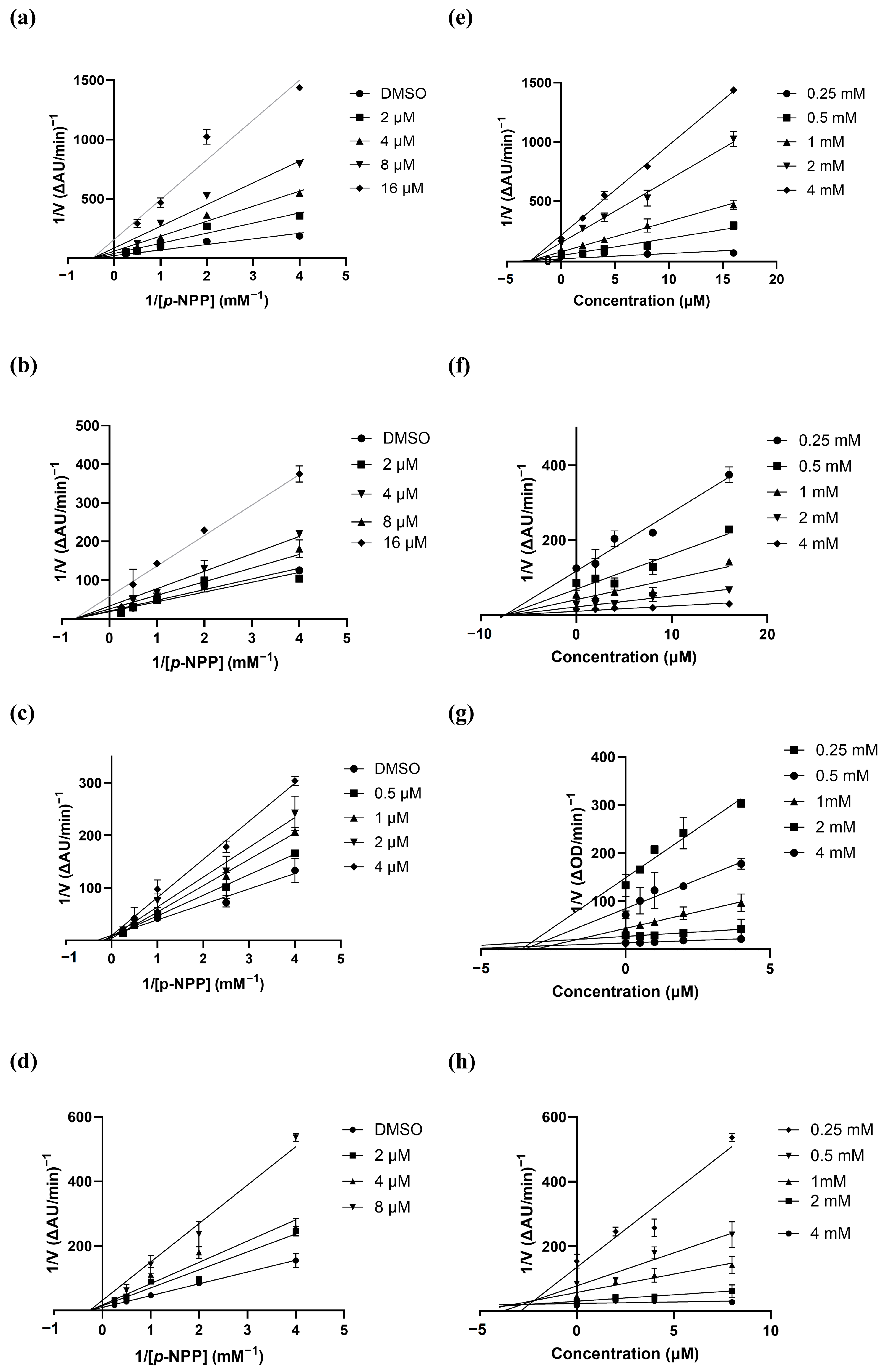
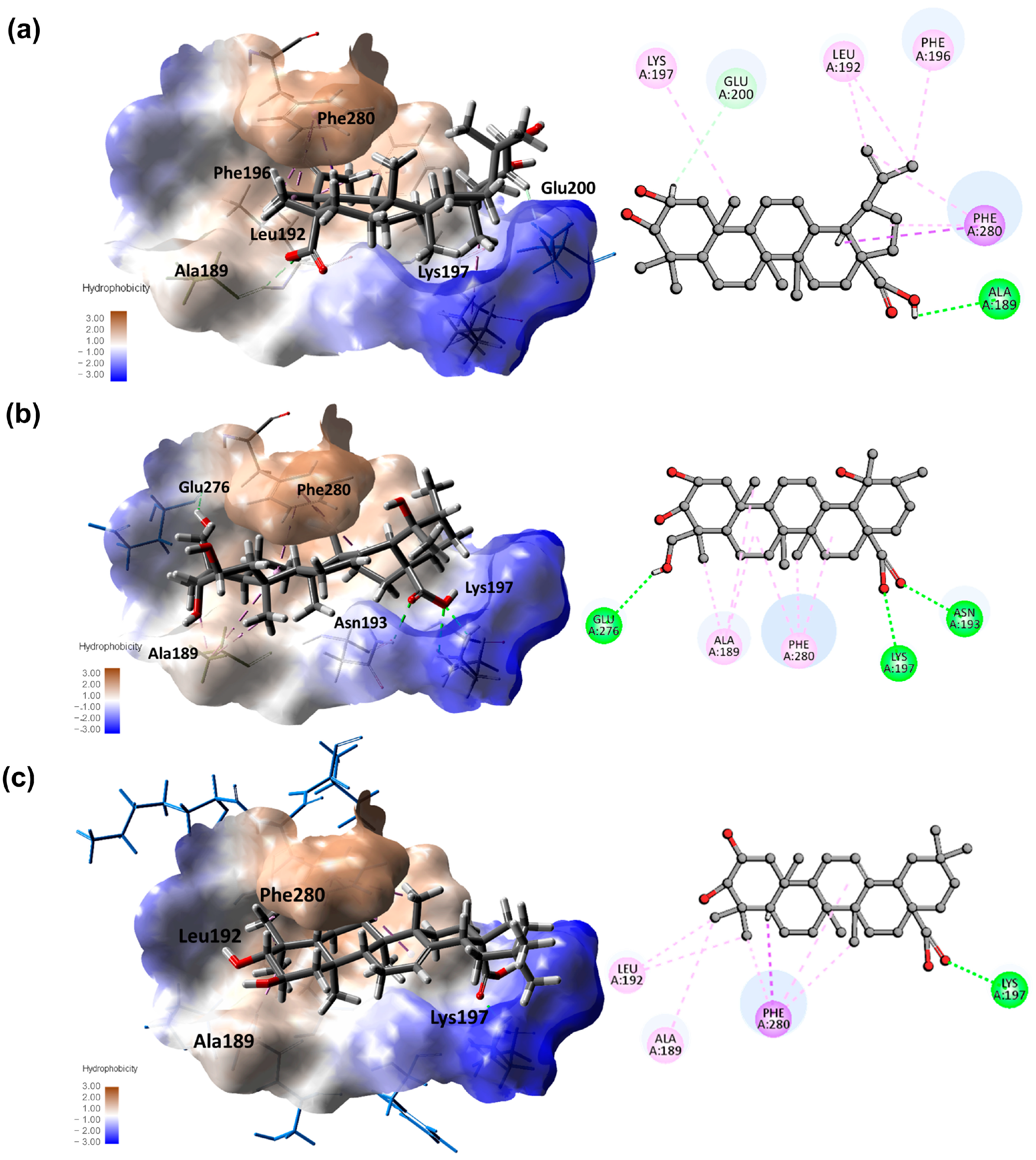
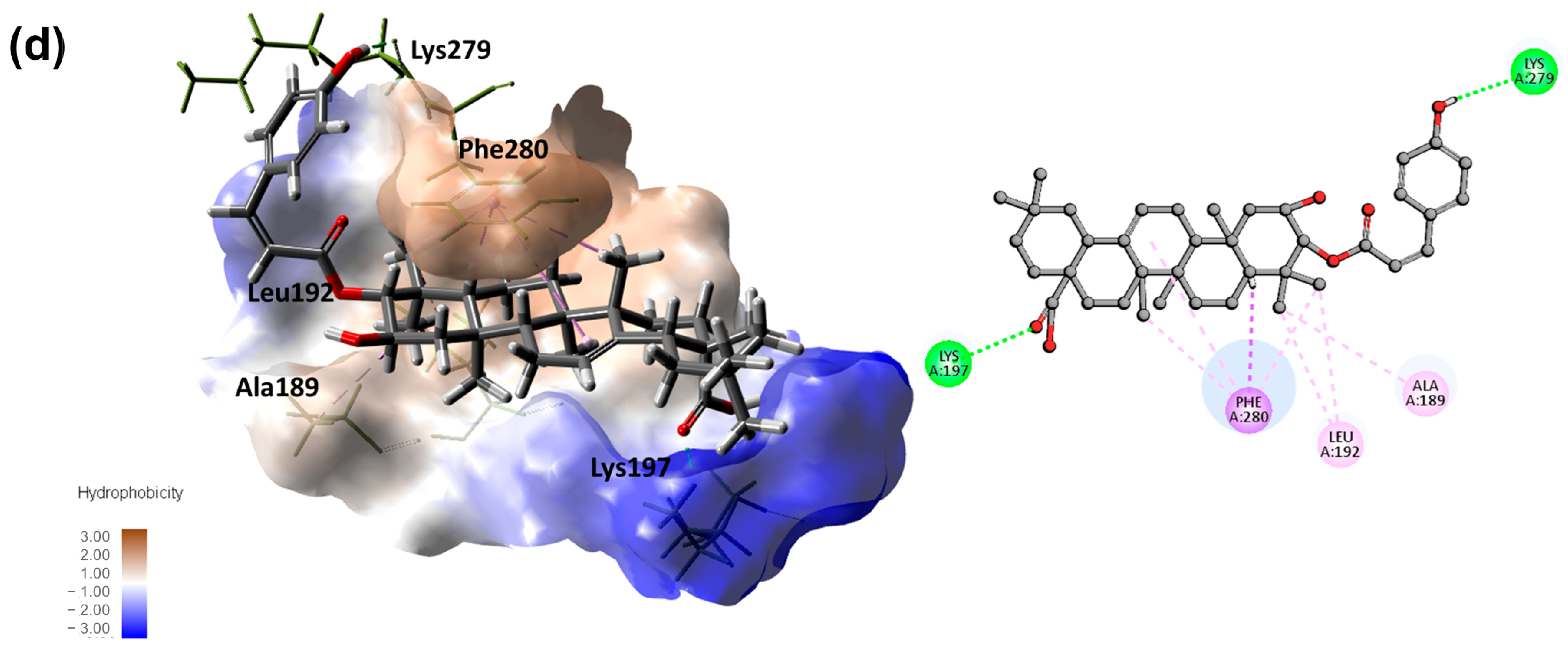
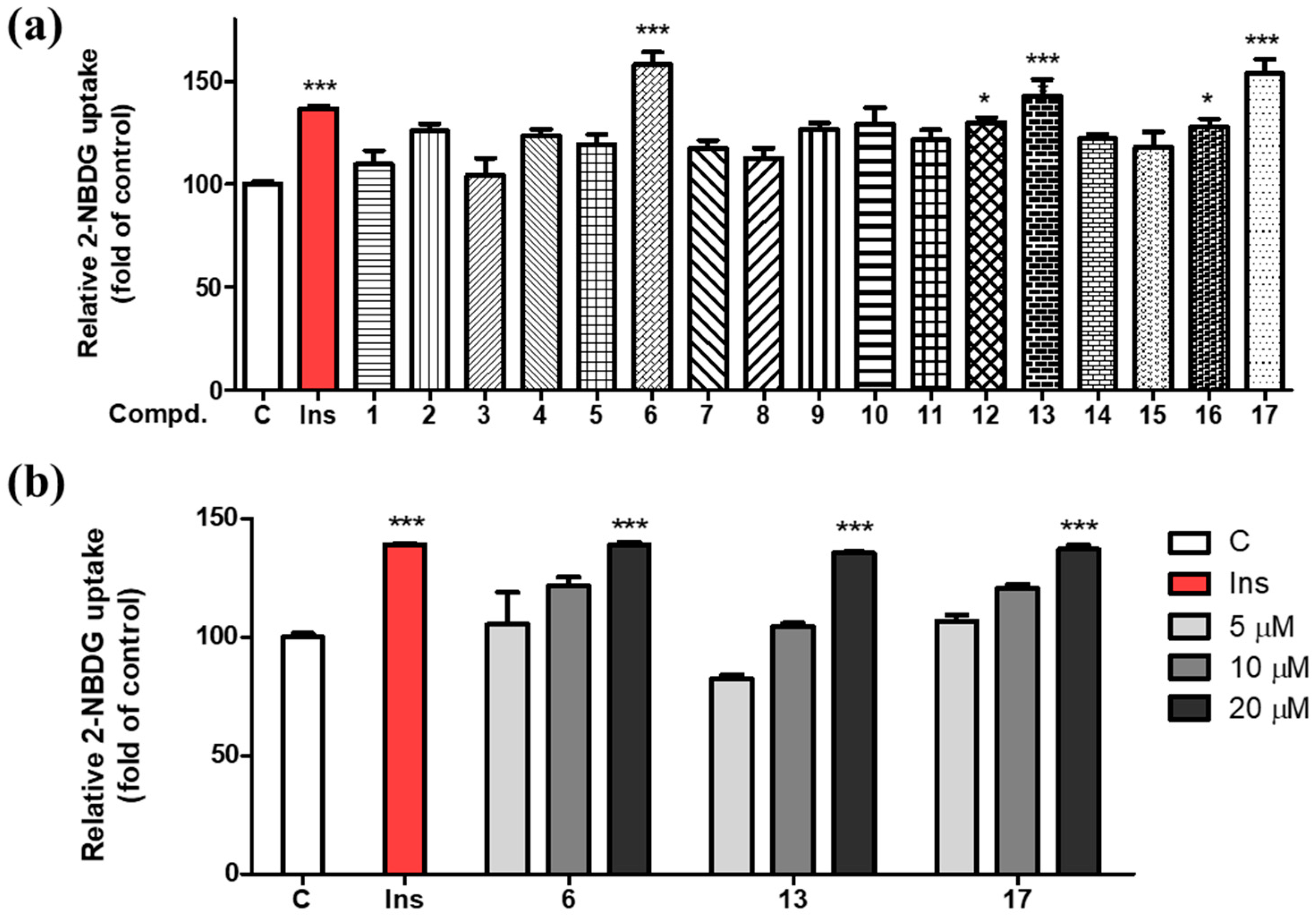
| Position | 1 | 2 | 3 | |||
|---|---|---|---|---|---|---|
| δH (J in Hz) | δC | δH (J in Hz) | δC | δH (J in Hz) | δC | |
| 1 | 1.73 d (13.1) 0.99 m | 39.8 | 1.75 m 1.08 m | 39.6 | 2.62 dd (12.7, 5.0) 1.72 m | 48.2 |
| 2 | 1.86 m 1.80 m | 28.8 | 1.92 m 1.86 m | 28.3 | 4.13 m | 73.7 |
| 3 | 3.27 dd, (11.3, 4.7) | 78.3 | 4.05 dd (11.3, 4.0) | 74.0 | 4.38 d (8.8) | 79.9 |
| 4 | 39.9 | 43.3 | 151.9 | |||
| 5 | 0.88 m | 56.5 | 1.54 m | 49.6 | 5.04 br d (12.2) | 50.4 |
| 6 | 1.62 m 1.42 m | 19.3 | 1.68 m 1.45 m | 19.2 | 1.64 m 1.50 m | 21.1 |
| 7 | 3.01 m 1.93 m | 38.8 | 2.15 m 1.87 m | 38.6 | 1.28 m 1.06 m | 30.5 |
| 8 | 41.3 | 41.3 | 42.3 | |||
| 9 | 1.93 m | 52.2 | 2.03 m | 52.2 | 1.90 br s | 50.1 |
| 10 | 38.3 | 38.2 | 38.7 | |||
| 11 | 1.57 m 1.31 m | 21.7 | 1.60 m 1.35 m | 21.7 | 3.32 dd (3.1, 2.4) | 55.3 |
| 12 | 2.79 m 1.89 m | 28.1 | 2.70 m 2.01 m | 27.4 | 3.07 d (3.7) | 56.8 |
| 13 | 2.79 m | 40.7 | 2.71 m | 40.7 | 89.7 | |
| 14 | 60.3 | 60.4 | 42.2 | |||
| 15 | 2.50 d (13.4) 1.57 m | 29.1 | 2.47 d (13.4) 1.56 m | 29.0 | 1.73 m 1.03 m | 27.5 |
| 16 | 2.68 m 1.93 m | 35.3 | 2.65 m 1.88 m | 35.4 | 2.31 m 1.42 m | 23.5 |
| 17 | 57.3 | 57.3 | 45.7 | |||
| 18 | 2.33 t (11.1) | 53.0 | 2.13 m | 52.9 | 1.88 m | 61.6 |
| 19 | 3.53 td (11.3, 4.7) | 44.2 | 3.51 td (10.9, 4.2) | 48.2 | 2.71 m | 36.6 |
| 20 | 156.5 | 151.2 | 152.4 | |||
| 21 | 2.20 m 1.63 m | 33.0 | 2.03 m 1.46 m | 31.3 | 2.23 m 2.29 m | 32.4 |
| 22 | 2.01 m 1.57 m | 37.5 | 2.02 m 1.45 m | 37.7 | 1.96 dt (12.9, 3.1) 1.62 m | 33.8 |
| 23 | 1.08 s | 29.0 | 4.10 d (10.3) 3.59 d (10.3) | 68.5 | 5.89 br s 4.99 br s | 105.7 |
| 24 | 1.01 s | 17.0 | 1.06 s | 13.5 | ||
| 25 | 0.91 s | 17.5 | 0.99 s | 17.8 | 0.91 s | 16.3 |
| 26 | 1.18 s | 17.9 | 1.20 s | 17.9 | 1.17 s | 20.7 |
| 27 | 178.8 | 178.8 | 1.18 s | 16.7 | ||
| 28 | 177.3 | 177.4 | 178.6 | |||
| 29 | 5.61 br s 5.38 br s | 107.3 | 5.04 br s 4.81 br s | 111.0 | 1.45 d (6.3) | 16.9 |
| 30 | 4.73 d (15.0) 4.56 d (15.0) | 64.7 | 1.89 s | 19.7 | 4.87 br s 4.81 br s | 108.7 |
| OCH3 | 3.77 s | 51.9 | 3.77 s | 52.0 | ||
| Compounds | IC50 (μM) | Inhibition Type b | Ki (μM) c |
|---|---|---|---|
| 1 | >20 | - | - |
| 2 | >20 | - | - |
| 3 | >20 | - | - |
| 4 | 8.7 ± 0.6 | - | - |
| 5 | 2.2 ± 0.1 | - | - |
| 6 | 4.1 ± 0.2 | Non-competitive | 2.8 ± 0.4 |
| 7 | >20 | - | - |
| 8 | >20 | - | - |
| 9 | 4.4 ± 0.5 | Non-competitive | 7.6 ± 1.2 |
| 10 | 12.2 ± 0.3 | - | - |
| 11 | 14.1 ± 0.3 | - | - |
| 12 | 1.7 ± 0.8 | - | - |
| 13 | 1.28 ± 0.1 | Non-competitive | 3.2 ± 0.6 |
| 14 | 3.6 ± 0.2 | - | - |
| 15 | 6.6 ± 0.6 | - | - |
| 16 | 3.6 ± 0.4 | - | - |
| 17 | 2.6 ± 0.3 | Non-competitive | 2.7 ± 0.4 |
| Ursolic acid d | 2.9 ± 0.2 µM | - | - |
| Libdock Score | Hydrogen Bond | Hydrophobic | Other Interactions | ||||
|---|---|---|---|---|---|---|---|
| π-π Stacked | π-σ | π-Alkyl | π Anion/Cation | π-Sulfur | |||
| 6 | 96.83 | Ala189 Glu200 | Phe280 | Lys197 Leu192 Phe196 | |||
| 9 | 81.57 | Asn193 Lys197 Glu276 | Ala189 Phe280 | ||||
| 13 | 104.44 | Lys197 | Phe 280 | Ala189 Leu192 | |||
| 17 | 106.92 | Lys197 Lys279 | Phe280 | Ala189 Leu192 | |||
| Docking control (PDB:1T4J ligand) | 148.67 | Asn193 Lys197 Phe280 | Phe280 | Ala189 Leu192 Phe196 | Phe280 | Met182 | |
Disclaimer/Publisher’s Note: The statements, opinions and data contained in all publications are solely those of the individual author(s) and contributor(s) and not of MDPI and/or the editor(s). MDPI and/or the editor(s) disclaim responsibility for any injury to people or property resulting from any ideas, methods, instructions or products referred to in the content. |
© 2024 by the authors. Licensee MDPI, Basel, Switzerland. This article is an open access article distributed under the terms and conditions of the Creative Commons Attribution (CC BY) license (https://creativecommons.org/licenses/by/4.0/).
Share and Cite
Ponce-Zea, J.-E.; Ryu, B.; Lee, J.-Y.; Park, E.-J.; Mai, V.-H.; Doan, T.-P.; Lee, H.-J.; Oh, W.-K. In Vitro and In Silico Analysis of PTP1B Inhibitors from Cleistocalyx operculatus Leaves and Their Effect on Glucose Uptake. Nutrients 2024, 16, 2839. https://doi.org/10.3390/nu16172839
Ponce-Zea J-E, Ryu B, Lee J-Y, Park E-J, Mai V-H, Doan T-P, Lee H-J, Oh W-K. In Vitro and In Silico Analysis of PTP1B Inhibitors from Cleistocalyx operculatus Leaves and Their Effect on Glucose Uptake. Nutrients. 2024; 16(17):2839. https://doi.org/10.3390/nu16172839
Chicago/Turabian StylePonce-Zea, Jorge-Eduardo, Byeol Ryu, Ju-Yong Lee, Eun-Jin Park, Van-Hieu Mai, Thi-Phuong Doan, Hee-Ju Lee, and Won-Keun Oh. 2024. "In Vitro and In Silico Analysis of PTP1B Inhibitors from Cleistocalyx operculatus Leaves and Their Effect on Glucose Uptake" Nutrients 16, no. 17: 2839. https://doi.org/10.3390/nu16172839
APA StylePonce-Zea, J.-E., Ryu, B., Lee, J.-Y., Park, E.-J., Mai, V.-H., Doan, T.-P., Lee, H.-J., & Oh, W.-K. (2024). In Vitro and In Silico Analysis of PTP1B Inhibitors from Cleistocalyx operculatus Leaves and Their Effect on Glucose Uptake. Nutrients, 16(17), 2839. https://doi.org/10.3390/nu16172839






